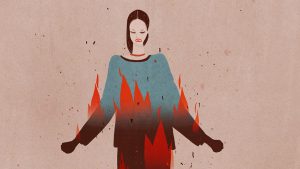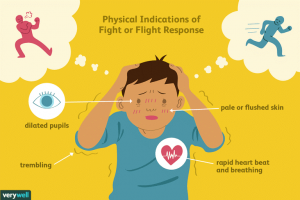When we perceive threat, our bodies initiate a fight-or-flight response (Cannon, 1932). This physiological reaction – involving symptoms such as quickened heart rate – prepares us for action. Although unpleasant, it is likely that this adaptive response enabled our ancestors to run from or fight predators, and therefore to survive and have a higher chance of reproducing. However, in modern environments, this response can be elicited by events like a job interview or an exam, which although far from enjoyable are (hopefully!) not life-threatening.
The emotion most commonly researched in association with threat is anxiety, which reflects the “flight” response, and is associated with avoidance of threat. Another common emotional response to threatening situations is anger (the “fight” response), however, this has been comparatively ignored (Kassinove & Eckhardt, 1995).
Anger has been theorised to function adaptively by providing a feeling of control, or by communicating mood/intent (Rothenberg, 1971). However, frequent or excessive anger interferes with daily life and wellbeing just as excessive anxiety does. Frequent occurrences of overt anger are associated with low self-esteem, as well as impaired work and social life (Deffenbacher, 1992).
Anger and anxiety thus reflect different emotional responses to the same threatening situation; preparing us for either fight or flight. Some suggest that anxiety is more likely to occur when a situation is unpredictable, in contrast to anger being a response to an identified clear threat (Lerner & Keltner, 2000). However, they are not mutually exclusive, and anger can follow from anxiety (Rothenberg, 1971). In support of this notion, individuals with anxiety disorders report higher levels of anger (Olatunji, Ciesielski & Tolin, 2010), the symptoms of anger attacks are similar to panic attacks (rapid heartbeat and breathing etc.; Fava & Rosenbaum, 1998), and the Diagnostic and Statistical Manual V criteria for post-traumatic stress disorder (PTSD) even includes “irritability or outbursts of anger” (Orth and Wieland, 2006).
“Anger and anxiety reflect different emotional responses to the same threatening situation”
Unlike anxiety, there is no disorder that directly maps to psychopathological levels of anger. The closest is ‘intermittent explosive disorder’, characterised by frequent, excessive and impulsive verbal or physical aggression. Aggression is usually considered as distinct to anger, but as a proxy it is interesting that this disorder is more prevalent in individuals with anxiety disorders (Kessler et al., 2006). In a population-based study, most types of anxiety disorder were associated with increased lifetime and recent symptoms of anger, as well as intermittent explosive disorder (Hawkins & Cougle, 2011).
The relationship between anger and anxiety may well reflect emotion regulation difficulties, whereby individuals struggle to control strong emotions (Kunimatsu & Marsee, 2012). This may explain why in children, emotional (e.g. anxiety) and behavioural (e.g. conduct disorder) problems often co-occur (Costello, Egger & Angold, 2004). Children are still learning to cope with the intense emotions they experience in response to threat, and are also still developing their inhibitory control. As discussed in one of our earlier blogs, children with anxiety find it particularly hard to regulate their emotions, including anger, and report experiencing them more intensely than other children (Suveg & Zeman, 2004).
A genetic overlap in predisposition to anger and anxiety has been proposed in terms of a sensitivity to threat or stressors (Barlow, 2002), however, most genetic studies have focused on aggressive tendencies rather than the emotional aspects of anger. One study investigating the association between anxiety and conduct disorder in children did find a genetic correlation (Gregory, Eley & Plomin., 2004) but no genetic studies have been performed specifically on measures of anger and anxiety.
“Understanding the relationship between anger and anxiety could be important to help people distressed by either of these emotions”
This is an intriguing area of research, however, the literature is pervaded by difficulties in defining anger, whether it has distinct components and how it differs to irritability and aggression. Although anger has been likened to the fight response, it can and often does occur independently of aggressive behaviours. We can experience anger but show no sign of it, express it in private, or direct it at others, indicating the range of ways in which anger can be expressed and extremes of which may be related to different disorders. Understanding the relationship between anger and anxiety could be important to help people distressed by either of these emotions, for example by implementing therapeutic approaches directed at both in cases where either has been diagnosed as a clinical problem.
NHS advice on anxiety, fear & anger
https://www.nhs.uk/conditions/stress-anxiety-depression/controlling-anger/
References
- Barlow, D. H. (2002). Anxiety and its disorders; The nature and treatment of anxiety and panic (2nd ed). New York, NY: The Guildford Press.
- Cannon, W. (1932). Wisdom of the Body. New York, NY: W.W. Norton.
- Costello, E. J., Egger, H. L., & Angold, A. (2004). Developmental epidemiology of anxiety disorders In T. H. Ollendick & J. S. March (Eds.), Phobic and anxiety disorders in children and adolescents (pp. 61–91). New York, NY: Oxford University Press.
- Deffenbacher, J. L. (1992). Trait anger: Theory, findings and implications In C.D. Spielberger & J. N. Butcher (Eds.), Advances in personality assessment (pp. 177-201). Hillsdale, NJ: Erlbaum.
- Fava, M., & Rosenbaum, J. F. (1999). Anger attacks in patients with depression. The Journal of Clinical Psychiatry, 60(15), 21-24.
- Gregory, A. M., Eley, T. C., & Plomin, R. (2004). Exploring the association between anxiety and conduct problems in a large sample of twins aged 2–4. Journal of Abnormal Child Psychology, 32(2), 111-122.
- Hawkins, K. A., & Cougle, J. R. (2011). Anger problems across the anxiety disorders: findings from a population‐based study. Depression and Anxiety, 28(2), 145-152.
- Kassinove, H., & Eckhardt, C. I. (1995). An anger model and a look to the future In H. Kassinove (Ed.), Anger Disorders: Definition, Diagnosis & Treatment (pp. 197-204). New York, NY: Routledge.
- Kessler, R. C., Coccaro, E. F., Fava, M., Jaeger, S., Jin, R., & Walters, E. (2006). The prevalence and correlates of DSM-IV intermittent explosive disorder in the National Comorbidity Survey Replication. Archives of General Psychiatry, 63(6), 669-678.
- Kunimatsu, M. M., & Marsee, M. A. (2012). Examining the presence of anxiety in aggressive individuals: The illuminating role of fight-or-flight mechanisms. Child & Youth Care Forum, 41(3), 247-258.
- Lerner, J. S., & Keltner, D. (2000). Beyond valence: Toward a model of emotion-specific influences on judgement and choice. Cognition & Emotion, 14(4), 473-493.
- Olatunji, B. O., Ciesielski, B. G., & Tolin, D. F. (2010). Fear and loathing: A meta-analytic review of the specificity of anger in PTSD. Behavior Therapy, 41(1), 93-105.
- Orth, U., & Wieland, E. (2006). Anger, hostility, and posttraumatic stress disorder in trauma-exposed adults: a meta-analysis. Journal of Consulting and Clinical Psychology, 74(4), 698.
- Rothenberg. A. (1971). On anger. American Journal of Psychiatry, 128(4), 454-460.
- Suveg, C., & Zeman, J. (2004). Emotion regulation in children with anxiety disorders. Journal of Clinical Child and Adolescent Psychology, 33(4), 750-759.



[…] This article looks at the relationship between anxiety and anger. “Fight” implies “anger” and “flight” implies anxiety. It is not clear how they are related. […]